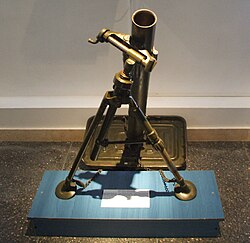Brandt Mle 27/31
| Brandt mle 27 | |
|---|---|
 Brandt Mle 27/31 on display at the Romanian Navy Museum. | |
| Type | Mortar |
| Place of origin | |
| Service history | |
| Used by | |
| Wars | Second World War |
| Production history | |
| Designer | Edgar Brandt |
| Specifications | |
| Mass | 56 kg (123 lb) |
| Barrel length | 1.26 m (4 ft 2 in) L/15.6 1.11 m (3 ft 8 in) L/13.7 |
| Crew | 3 |
| Caliber | 81 mm (3.2 in) |
| Rate of fire | 18 rounds per minute |
| Effective firing range | 1,000 to 1,900 m (1,093 to 2,078 yd) |
The Brandt mle 27/31 mortar was a regulation weapon of the French army during the Second World War. Designed by Edgar Brandt it was licensed built or copied by numerous countries.
Description
The Brandt mle 27/31 was a simple and effective weapon, consisting of a smoothbore metal tube fixed to a base plate (to absorb recoil), with a lightweight bipod mount. The mle 27/31 could be disassembled into 3 loads and a normal crew was 3 men. When a mortar bomb was dropped into the tube, an impact sensitive primer in the base of the bomb would make contact with a firing pin at the base of the tube, and detonate, firing the bomb towards the target.
Mortar bombs fired by the weapon weighed either 3.25 kilograms or 6.9 kilograms.
This weapon along with the Stokes Mortar provided the pattern for most World War II era light mortars. France, Russia, Italy, Japan and the United States all had weapons built from this design many times with similar weights, dimensions and performance. The ammunition fired by each was often compatible as well. Romania license-built the Mle 27/31 mortar prior to and during the Second World War.
References
- Dictionnaire de la Seconde Guerre mondiale, 1982 ed.
- Ferrard, Stéphane. "Les mortier Brandt de 60 et 81 mm dans l'Armée française en 1940"
External links
